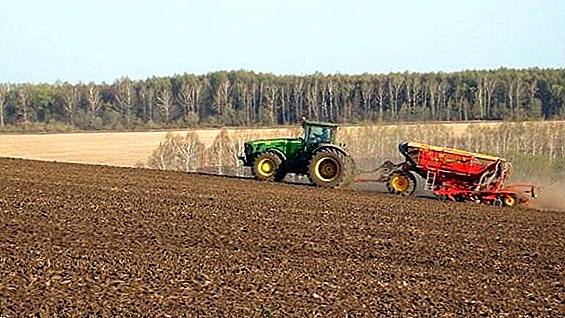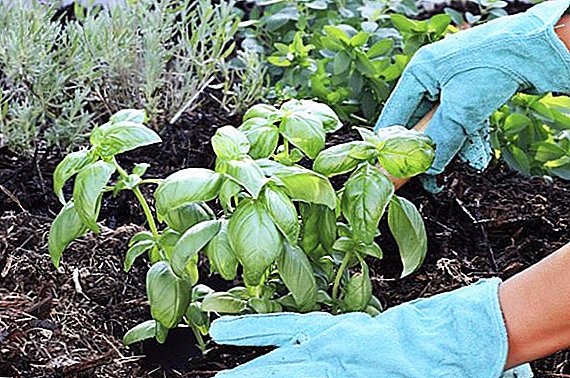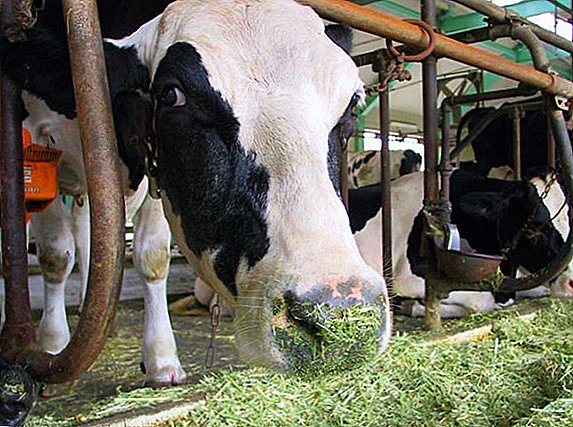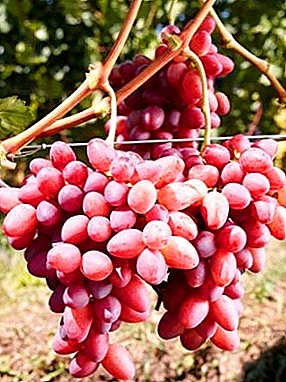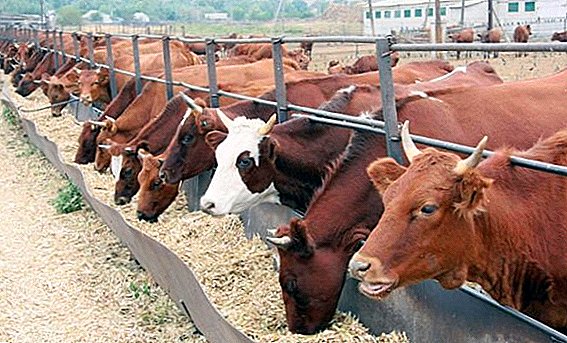 Breeds of cows meat and dairy areas are distinguished by their versatility. Usually they are divided into two types: meat and dairy and milk and meat depending on which qualities are more pronounced. When choosing a particular breed, it is necessary to take into account the purpose for which the animal is harnessed, and productive indicators, and conditions of detention with a diet. There are several basic meat and dairy selections with characteristic differences, which you will learn about in more detail below.
Breeds of cows meat and dairy areas are distinguished by their versatility. Usually they are divided into two types: meat and dairy and milk and meat depending on which qualities are more pronounced. When choosing a particular breed, it is necessary to take into account the purpose for which the animal is harnessed, and productive indicators, and conditions of detention with a diet. There are several basic meat and dairy selections with characteristic differences, which you will learn about in more detail below.
The main differences of the combined cattle breeds
Here are the main features that these breeds possess:
- universality is the main feature of such animals. Both meat and dairy qualities are well developed in them. That is, they can be maintained both for the purpose of obtaining milk, and for slaughter and for obtaining meat;
- cows of combined breeds are simpler in maintenance, as they are less picky in feeding. Unitary cattle need a special selection of the diet;
- they gain weight and mass relatively quickly;
- individuals quickly adapt to new conditions and are suitable for breeding in a cool climate;
- mating can be carried out with the same combined breeds, and unitary.
The best meat and dairy breeds
Such combined selections are becoming more popular. They are easier to maintain, more easily adapted and suitable for all content purposes. The most popular breeds of this direction and their productive indicators will be discussed further.
Did you know? Cows accompany the creation of a greenhouse effect on Earth. They harm the environment even more than all cars combined - their manure and gases make up more than 18% of the total contribution to the greenhouse effect.
Alatau
The breed was obtained in the 50s of the last century by Soviet scientists. Homeland has become foothill Kazakhstan, and since the climate there is more than harsh, the cows are distinguished by their unpretentious care and good adaptability.  Animals have small legs, but they are very powerful and strong, the same small neck and chest part. The individual grows to 130-150 centimeters tall. Growth is quite fast, like weight gain, and it doesn’t matter how much the individual feeds. An interesting feature of the breed - sagging ass. Cows are distinguished by a dense and strong constitution and pronounced meat forms.
Animals have small legs, but they are very powerful and strong, the same small neck and chest part. The individual grows to 130-150 centimeters tall. Growth is quite fast, like weight gain, and it doesn’t matter how much the individual feeds. An interesting feature of the breed - sagging ass. Cows are distinguished by a dense and strong constitution and pronounced meat forms.
Productive breed indicators:
- weight gain passes very soon: bulls grow quickly, already in 6 months they can gain up to 500 kilograms, and then - and up to 1 ton in adulthood (after 1 year). Chicks gain up to 600 kilograms in one year of life;
- meat yield in the breed - 60%. Meat content is quite high;
- milk - tasty and not very fat. The indicator of fat content of the product varies around 3.9-4.0%. One cow gives up to 4-5 thousand liters of milk per year;
Recommend reading: Only the most interesting about cows.
Bestuzhevskaya
It was received in Russia, at the turn of the XVIII-XIX centuries in the territories of the modern Ulyanovsk region. The selection itself is not purely Russian, in its creation were used the genes of European breeds (Dutch, Shorthorn), to which were added a few local, having received such a positive result. The name received from the landowner Bestuzhev, who was engaged in breeding breeding.  The height of individuals is medium, about 120-130 centimeters at the withers. The constitution is medium, animals look strong, with well-developed bone system. They are distinguished by red color, like in red Gorbatov ones, but with a lighter shade of wool, sometimes there are individuals with a darker type of color. A distinctive feature is the immune system - it is resistant to many diseases, including leukemia and tuberculosis. Quite an economical breed, as it calmly consumes coarse types of feed.
The height of individuals is medium, about 120-130 centimeters at the withers. The constitution is medium, animals look strong, with well-developed bone system. They are distinguished by red color, like in red Gorbatov ones, but with a lighter shade of wool, sometimes there are individuals with a darker type of color. A distinctive feature is the immune system - it is resistant to many diseases, including leukemia and tuberculosis. Quite an economical breed, as it calmly consumes coarse types of feed.  Bestuzhevki please such indicators:
Bestuzhevki please such indicators:
- gaining weight quickly, the weight indicators are quite high: bulls can weigh up to more than 1 ton, cows - from 400 to 700 kilograms;
- meat yield - above average, at least 55%;
- milk indicators very tall. They can compete with pure dairy breeds, since in a year one cow produces more than 5 thousand liters of milk (and at least 3 thousand liters). It has a rich and tasty taste, fat content is above average - 3.8-4.0%, and in terms of feeding with fresh juicy green grass it can reach 5.5%.
Learn more about Bestuzhevskaya breed of cows.
Brown Carpathian
It was bred in the Carpathians in the middle of the XX century. It originated from local breeds, so-called makonec or ryzhek, which were crossed with Schwyz, Algauz and Swiss individuals.
The constitution is strong, the skeleton is dense and light, the hoofed horn is strong, as the cattle adapts well to mountain conditions. The body is short, but the chest is quite wide. The growth of animals varies at elevations of 120-130 centimeters, the suit is usually light with an admixture of brown and ginger.  Main productive characteristics:
Main productive characteristics:
- weight gain passes quickly - by the age of one year the bulls gain about 350 kilograms. The average weight of an individual is 450-500 kilograms. Adult bulls can weigh up to 700 kilograms;
- meat yield - good, slightly above average. Usually from one individual you can get up to 55-58% pure meat;
- milk production makes 3-4 thousand liters of milk a year. The average fat content is 3.5-4.5%, the product has a delicate taste and good aroma.
Check out the tips for choosing a good milch cow.
Yorkshire
The Yorkshire were bred in the middle of the XVIII century in the territory of Yorkshire County, from which they got their name. In the XIX century, spread throughout Europe due to its productive performance.  Cows differ in a red-motley color, shades can be different in intensity. The constitution is strong, all parts of the body are proportionally developed. The height of the individual at the withers is approximately 130 centimeters. Externally, the cattle looks quite powerful, but in fact the animals are friendly and calm.
Cows differ in a red-motley color, shades can be different in intensity. The constitution is strong, all parts of the body are proportionally developed. The height of the individual at the withers is approximately 130 centimeters. Externally, the cattle looks quite powerful, but in fact the animals are friendly and calm.
These cows:
- weight gain very fast, much more intense than the rest of the combined breeds of cattle. The live weight of a cow varies around 500 kilograms, the weight of adult bulls is approximately 800 kilograms;
- meat yield - average, about 45-50%;
- milk indicators - very high, milk yield may be 4.5-5 thousand liters of milk per year. Fat content is from 4.4% to 4.6%.
Important! A peculiarity of the Yorkshire breed is also a rapid puberty. Calves develop at such a rate that it is already possible to carry out insemination of heifers for 14 months and get offspring. The breed is well suited for breeding not only with the aim of obtain meat or milk, but also to increase the number of herds.
Caucasian brown
It was withdrawn by Soviet scientists in the 50s of the last century. It appeared on the territory of the whole Caucasus, since the breeding centers were scattered, because there are still disputes over the breed's homeland, some consider it Armenia, others - Azerbaijan or Dagestan. It was bred from Caucasian breeds mixed with Schwyz, Kostroma and Lebedin cows.  The body of these cows is dense, the legs are strong, but short, the constitution is tall and strong. The animal looks strong and durable, has a thick skin and thick hair, and therefore tolerates climate change and temperature drops. Color mainly close to brown in different shades. Height - low, about 120 centimeters at the withers, rarely when it exceeds 130 centimeters.
The body of these cows is dense, the legs are strong, but short, the constitution is tall and strong. The animal looks strong and durable, has a thick skin and thick hair, and therefore tolerates climate change and temperature drops. Color mainly close to brown in different shades. Height - low, about 120 centimeters at the withers, rarely when it exceeds 130 centimeters.
Important! Caucasian cows are the leaders of the birth of twins. Breed feature - calves are born small (only 25-30 kilograms), but cows give birth much more often than other selections. In addition, in the standard of this breed, twins are often born, and even triplets, this is considered normal.
Productive characteristics of Caucasians:
- weight gain passes relatively quickly. Cows weigh about 600 kilograms, bulls - 850-900 kilograms;
- meat yield - 50-55%, not more;
- milk indicators - unique and ambiguous. In general, it will not be possible to get large milk yields - a cow gives no more than 3.5 thousand liters of milk with a fat content of 3.5%, which is quite a bit. But in terms of its performance, it is more than unique - its taste is so high that it is often used to make delicacies, tasty, expensive cheeses.
Kostroma
The breed has an interesting breeding history - it was created in the conditions of war specifically for the rapid production of high-quality products. It was officially registered in 1945 in Russia and is considered one of the best meat and dairy breeds.  These animals are long-lived with strong, stately, build and medium size. The body is well developed, but the legs are short. Resistant to many diseases, especially leukemia. The colors can be red or gray, with all variations of shades.
These animals are long-lived with strong, stately, build and medium size. The body is well developed, but the legs are short. Resistant to many diseases, especially leukemia. The colors can be red or gray, with all variations of shades.
The main indicators of the breed:
- weight gain - relatively fast, bulls are gaining 900 kilograms, calves - about 550-700 kilograms. Calves are born average, weighing about 40 kilograms;
- meat yield - 65%, because the breed can compete with the rest on this item;
- milk indicators uniquely high - they are equal to 4-7 thousand liters of milk per year (fat content - 3.9%). It has a high content of lactose, about 5%, because the product stands out significantly from the rest.
Did you know? Cows are pretty musical creations. Zoologists believe that they can moo with different intonations. Now there are about eleven different tones with which the animal can communicate.
Krasnaya Gorbatovskaya
It was bred in Russia in the last century. Got selection by crossing local and Tyrolean cows.
The breed itself is small, usually an individual has a height of not more than 120 centimeters. Visually, the animal looks elongated, this is due to the fact that the back is quite wide, and the chest has a size of only 35-40 centimeters. The back is often sagging, the udder is small and well developed. The color, as the name implies, is mostly red, bright and saturated, sometimes there are white blotches. Most often, cows are lighter in color than bulls. They have good immunity and are valued for their high resistance to many dangerous diseases, including infectious diseases, especially leukemia, brucellosis and tuberculosis.  The most important indicators:
The most important indicators:
- weight gain - medium, as cattle growth is small. Cows weigh 600 kilograms, bulls - 900. Calves are born small, only 25-28 kg weigh;
- meat yield - average, 55%;
- milk indicators - small, about 3,000 liters per year, but it is characterized by high levels of fat content - from 4.2%. Sometimes there is milk and 6% fat.
Read more about the Krasnogorbatovskaya breed of cows.
Red Danish
Red Danish were derived in the middle of the XIX century from the Anglers breed. In breeding, representatives of short-horn cattle were crossed with the aforementioned breed, often purebred Danish bulls took part in the insemination process, giving Danish red many advantages, such as a strong build and body weight.  The height of the animal at the withers varies around the mark of 130 centimeters. The constitution of representatives of Danish cows is strong, the body is long and wide, the back part is rather wide, the sternum is large. The legs are of medium length, like the neck, the skeleton as a whole is strong, the horns are set wide. Well developed udder - bowl shape. The main color of the cows is red, there is a darker shade. In cows, the udder or lower abdomen sometimes covers a small amount of white spots of medium size.
The height of the animal at the withers varies around the mark of 130 centimeters. The constitution of representatives of Danish cows is strong, the body is long and wide, the back part is rather wide, the sternum is large. The legs are of medium length, like the neck, the skeleton as a whole is strong, the horns are set wide. Well developed udder - bowl shape. The main color of the cows is red, there is a darker shade. In cows, the udder or lower abdomen sometimes covers a small amount of white spots of medium size.  Danish cows have:
Danish cows have:
- weight gain occurs quickly, like the rest of the meat and dairy breeds. The weight of cows often fluctuates, according to the standards of the breed, it can be from 550 to 800 kilograms. Bulls are gaining more than 1 ton. Calves weigh about 35 kg when born;
- meat yield at slaughter - medium, exactly 50%;
- milk indicators on average, equal to 9 thousand liters of milk per year, which is very much. Under conditions of good maintenance and full-fledged feeding, even greater indicators can be achieved - from 11 to 18 thousand liters per year. Milk fat is high, 4.2 (the amount of protein is 3.5%).
It is interesting to read about the hornless breeds of cows.
Lebedinskaya
Appeared on the territory of Ukraine in the last century, the Sumy region, the village of Lebedin is considered the birthplace. Ukrainian gray breeds and Swiss cows participated in the breeding.
The color of animals is usually light, brown and red colors predominate, sometimes they are combined, sometimes there are individuals with a gray color. The front of the body is usually slightly darker, and around the nose there is a gray band. The skeleton has much in common with Schwyz individuals, but more robust and slightly larger. The body is long, the back is wide, the chest is large and deep, the legs are medium in size and very strong. The skin, though thick, with thick hair, is elastic. The head is short, the udder is voluminous and well developed. Height at withers ranges from 130 to 140 centimeters.  Productive characteristics of this breed:
Productive characteristics of this breed:
- weight gain it passes quickly in cows, usually weighing 500-550 kilograms. Bulls are gaining 850-950 kg;
- meat yield - quite large, you can get from 55 to 63% pure meat. Appreciated for taste and juiciness;
- milk indicators - high, from 3.2 to 5 thousand liters per year (fat content of 3.6-3.9%). With good nutrition, you can achieve indicators of 12.5 thousand liters with a fat content of more than 4%.
Did you know? Before, the cow was currency. Before the advent of money as such, these animals were used in everyday life. The calculations were carried out in cows, and the value of material values was measured by them.
Simmental
The breed was formed in Switzerland, in the valleys of the Sima River. It became famous at the beginning of the XIX century, when it spread throughout the world and the territory of Russia. Now there are several main types of breed, bred in the process of its distribution: steppe, Volga, Far Eastern, northern and others.  The animals themselves have a strong and powerful physique, the sternum is large and wide, the back is even. The legs are medium in size, the neck is short, the horns are set wide apart. Growth in withers is 140 centimeters, in bulls, this figure may be higher. Color - pale-motley, often with a shade of red or red. Often, the representatives of the selection have a white head, and the color on the legs and the bottom of the body is white-motley.
The animals themselves have a strong and powerful physique, the sternum is large and wide, the back is even. The legs are medium in size, the neck is short, the horns are set wide apart. Growth in withers is 140 centimeters, in bulls, this figure may be higher. Color - pale-motley, often with a shade of red or red. Often, the representatives of the selection have a white head, and the color on the legs and the bottom of the body is white-motley.  Important indicators for the farmer:
Important indicators for the farmer:
- weight gain - fast, in chicks reaches 600-700 kilograms. Bulls weigh more, usually from 770 to 1000 kg. Calves at birth often weigh 40-45 kg. They are valued for their rapid growth, in the first year the calf gains up to 400 kilograms;
- meat yield - large, from adults, you can get 68-70% pure meat, in young animals it is lower, about 55%. The disadvantage is a large number of bones in the meat;
- milk indicators equal to 3.5-4 thousand liters per year with fat content of 4%.
Read more about Simmental cows.
Suksun breed of cows
Appeared in the Perm province at the beginning of the XIX century, where it is actively divorced now. The first representatives were obtained by crossing local cows with Danish red bulls.  The constitution of animals is elongated, but rather strong, the skeleton is well built, proportional. Usually the head and neck are medium, the chest is narrow but deep. The back is large, flat, wide. Udder - medium, skin - thin. The growth of a cow is 128-130 centimeters. Color - mostly red with different shades.
The constitution of animals is elongated, but rather strong, the skeleton is well built, proportional. Usually the head and neck are medium, the chest is narrow but deep. The back is large, flat, wide. Udder - medium, skin - thin. The growth of a cow is 128-130 centimeters. Color - mostly red with different shades.
Important! The breed has several obvious drawbacks: limb sabbiness (the angle of the hind leg joint is less than 140 degrees, which shortens the step and almost always leads to lameness), as well as muscle weakness. When breeding these factors must be taken into account, creating conditions for the maintenance of animals. Recommended meticulous care and inspection of the limbs, the inclusion in the diet of additional vitamins that strengthen the skeletal system.
Suksun cows have a plus, they are especially resistant to diseases, very rarely suffer from leukemia or tuberculosis. In addition, well adapted to any environmental conditions.
Productive characteristics:
- set weights: for cows, the average is 500 kilograms, and for bulls - 950 kg. Calves are born small, calves weigh about 28, and bulls - 30 kg;
- meat yield - average, 55%;
- milk indicators equal to 4 thousand liters per year with fat content of 4%.
Schwycka
Representatives of this breed are considered among the oldest. They appeared on the territory of Switzerland back in the XIV century, quickly spread throughout Europe and became very popular with almost all the inhabitants of the then countries, especially for their unpretentious diet and good dairy and meat data.  The chest of these cows is wide, according to standards has a size of 70 centimeters, and the height of an individual is 130 centimeters. Cows look stocky, stand well, stand firmly on their feet. By the way, the legs are rather short, but this does not interfere with good balance, as they are widely set. Wool - short, but with a dense undercoat that makes in cold climates. The color is light, usually gray or blue.
The chest of these cows is wide, according to standards has a size of 70 centimeters, and the height of an individual is 130 centimeters. Cows look stocky, stand well, stand firmly on their feet. By the way, the legs are rather short, but this does not interfere with good balance, as they are widely set. Wool - short, but with a dense undercoat that makes in cold climates. The color is light, usually gray or blue.  Representatives of this breed:
Representatives of this breed:
- gaining weight very fast. Calves per year grow to 350 and even 400 kilograms. An adult cow weighs about 800 kg, the bull easily steps over the mark of 1200;
- have meat yield - above average, equal to 58-60%;
- possess milk indicators not less than 4 thousand liters, often 4.5 thousand per year. Fat content is above average, 3.8%.
Learn more about Schwieck cows.
Yakut
Appeared on the territory of Yakutia, Russia. История породы также довольно древняя - она была получена от местных бурёнок, которых разводил народ саха, живший на этой территории ещё в XII веке. Кстати, долго считалось, что климат тех земель не позволяет содержать такое животное, как корову, но ещё до революции учёные развенчали подобный миф, основываясь на артефактах, полученных при исследованиях.  The first and brightest distinguishing feature is the lack of clear color parameters, the color palette is very diverse. Also, the breed is considered one of the smallest, the maximum growth of an average cow does not exceed 110 centimeters. The body is powerful and strong, the head is large, like the neck, but short. Legs - short but strong, set wide apart.
The first and brightest distinguishing feature is the lack of clear color parameters, the color palette is very diverse. Also, the breed is considered one of the smallest, the maximum growth of an average cow does not exceed 110 centimeters. The body is powerful and strong, the head is large, like the neck, but short. Legs - short but strong, set wide apart.  Yakut cows have the following characteristics:
Yakut cows have the following characteristics:
- weight gain - small, cows weigh about 360 kg, bulls - about 530-550 kg;
- meat yield - average, 52%. It seems that it is not much, but if we take into account the extreme conditions in which the cows were bred, the performance is more than high;
- milk indicators also low, the yield is 1.3-1.4 thousand liters of milk per year, but the fat content is a record high, 6%.
Read also about the Yakut mini-cow.
Meat and dairy breeds of cows - one of the most popular in the territories of many countries. They are distinguished not only by large indicators of milk yield and meat yield, but also by unpretentiousness to the conditions of detention and care. And still such animals - the best option for small farms and private farms.



